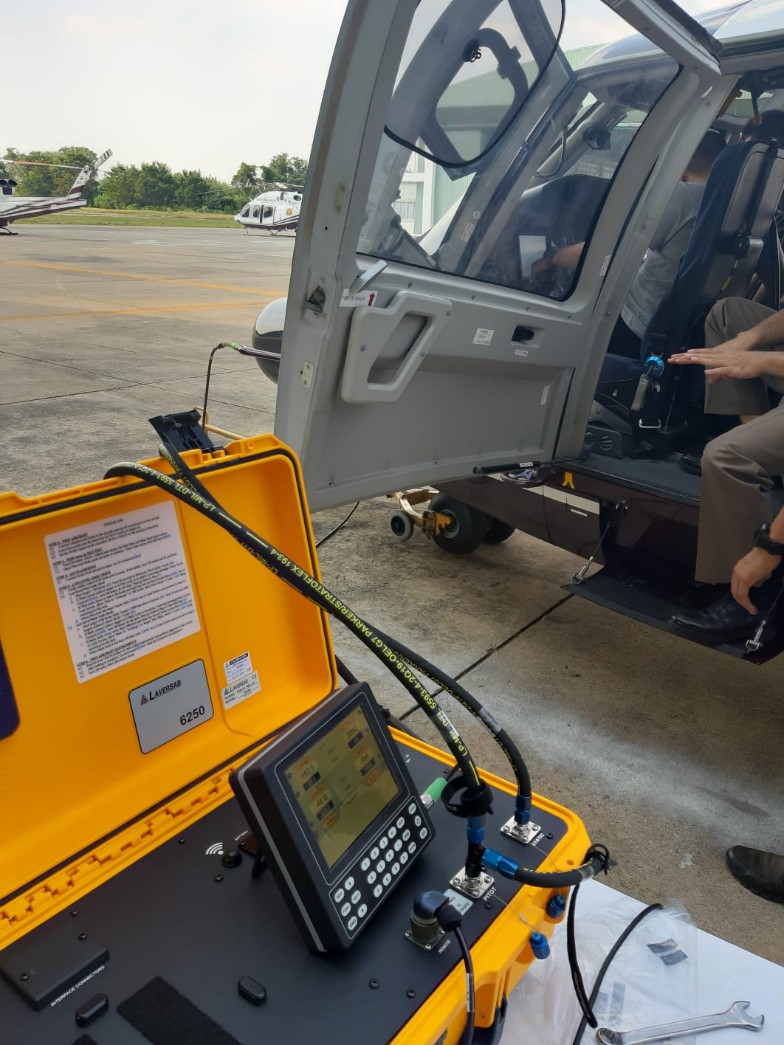We test a police helicopter in the Asian jungle!
Toward the end of 2019, the city police department of a major south-east Asian city tasked the Laversab Asia-Pacific team with helping them better manage their helicopter fleet. The helicopters are primarily used for search & rescue operations, escort of VIPs and deployed in the southern part of the country for peacekeeping and law enforcement. Given these important missions, it is critical to maintain top notch airworthiness for these helicopters, and this is why the Laversab team was called to the rescue.

The fleet’s helicopters mainly include military & commercial versions of the Bell 212, Airbus EC175, and AS365, which are fairly old and have been in service for a long time. Given the humid south-east Asian jungle, it is common to find slightly rusted pitot tubes and corroded static ports on the fuselage, and this time was no exception given that these helicopters were older than average. Moreover, the fleet technicians had been forced to use hand-pump-operated testers for many years, which involved a lot of manual labor and trial & error in this difficult environment.
Given that this request was specifically for helicopters without Reduction of Vertical Separation Minimum capability (RVSM), Laversab would typically recommend the Model 6200 Pitot-Static Tester. However, the police department selected the Model 6250 RVSM for a few reasons. First, the Model 6250 has powerful internal pumps and stable control and has proven to be an excellent way to debug and isolate the leaks for many customers. Second, the Model 6250 gave the police department flexibility to use the tester on other fixed wing RVSM aircraft in the same squadron. As with most repair stations around the world, preference always goes to spending a few hundred dollars extra to get equipment that can carry a wider spectrum of testing in case of unforeseen situations.
The city police department also selected the Laversab Universal Pitot-Static Adapter (UPSA) to connect the Model 6250 to their helicopters. The UPSA is a versatile Pitot and Static adapter tool for many standard aircraft. It provided the police department a way to connect the aircraft pitot-static system on these varied models of helicopters with different geometries of pitot tubes and often angled static ports. The adapter kit has its own small vacuum pump to hoist the suction cups and ensure the static ports are properly sealed and weight of the hoses is well balanced in this harsh windy environment in the jungle.
We used a specifically written procedure for the technicians to use in their native language and that was approved by authorities. The language may change, but the pressures points were the same as instructed in the original Aircraft Maintenance Manual. The avionics suite on these choppers were modern Garmin equipment, even though some of them were equipped with older analog gages. As we performed the demonstration, some engineers from Bell were working on upgrading one of the helicopters, redoing the entire wiring by laying it down on the floor, and then cautiously rebuilding it inside the chopper, followed by pneumatic connections. Our Laversab would come next to test the entire system and put it back into service.
Sometimes, aircraft will come back in for other reasons: pilots will complain of an airspeed or altitude disagree between both sides and request the aircraft to be tested and returned into service as soon as possible. To address this time constraint, the police department was pleased to learn about a convenient way to troubleshoot and locate leaks by connecting an iPad or Android device to the Model 6250 over WiFi. While the tester remained stationary, the technician could move around the helicopter looking for leaks in fittings and other common areas where leaks are usually found. The leak tests become easy and convenient with the Model 6250 because of the intuitive way of displaying leaks as measured by the test system in real time.
On this particular Model 6250 system, the police department did not have the removable battery installed, but they expressed a strong interest in having a system that could operate for extended period of time without power access. This is an important concern for remote bases where hangar space is limited, and typical pitot-static tests are performed on the tarmac or in the field. Laversab offers factory upgrades in such instances where battery options are not originally ordered. For the city police department, Laversab will have a battery pack installed on their test boxes when the unit are sent to Laversab for annual calibration at our local Taiwan office.
Using Laversab owned service centers and calibration facilities is the ideal way to service the city police department’s units. With a quick turnaround, the units can be upgraded, warranty claims addressed, or calibration services can be scheduled and performed. Laversab looks forward to continuing to work closely with the city police.
Aravind
Sales Manager Asia-Pacific
